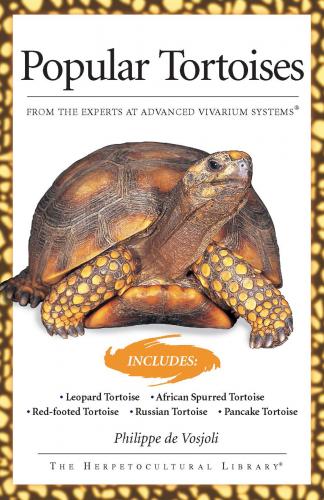Careful attention to selection will significantly increase your chances of purchasing a healthy animal. Whether your prospective tortoise is captive-bred or wild-caught, use the following criteria for selection:
1) If the tortoise is awake, it should appear wide-eyed. Half-open, swollen, and watery eyes are signs of possible illness. Look for an active or feeding specimen. Its eyes must not appear sunken and the cheeks must appear rounded, with no visible outline of the cheekbones. The nostrils must be clear and free of mucus. If possible, gently press your thumb against the throat of a tortoise. If mucus emerges from the nostrils, the tortoise may have a respiratory infection. Avoid gaping tortoises and those with forced exhalations—these are two common symptoms of pneumonia.
2) Ask to handle the tortoise. A healthy tortoise should give the impression of good weight for its size. If you are surprised by how light a tortoise is, it may be a sign of disease. A healthy tortoise demonstrates muscular vigor. A strong response of withdrawal into the shell is a good sign. A strong withdrawal response when you gently pull on a hind leg indicates potentially good health. Avoid animals that give the impression of being limp.
3) Closely examine the carapace (dorsal or top part of the shell) and plastron (ventral or underside part of the shell) for signs of injury or bleeding beneath the epithelial (surface) layer. Do not purchase animals with subepithelial (below the surface) shell bleeding. Look for any swelling of individual limbs. Examine the eyes and the sides of the head. Avoid specimens with swelling of the cheek areas. If you look at the head from above, it should appear bilaterally symmetrical.
4) Check the edges of the beak of the tortoise, looking for breaks, swelling, or caseous material; avoid animals with these symptoms.
5) Examine the vent area—the opening to the cloaca (the chamber into which the genital, urinary, and digestive canals empty their contents) located at the base of the tail. It should be flush with the base of the tail, not swollen or crusty. Watery fecal smears around the vent are a sign of parasitism and/or enteritis (see Diseases and Disorders). Check the fecal matter in the tortoise’s enclosure. Watery feces are typical signs of parasitism and gastroenteritis. Large amounts of urates (excreted waste) that are white and chalky in appearance can be a sign of kidney disease. Keep in mind, however, that newly imported animals may have watery feces at first; with proper care, the feces should firm up. If a turtle appears otherwise healthy but has watery feces, it must be checked and treated for parasites. Healthy tortoises have soft, formed, and often fibrous feces.
Male or Female?
Before purchasing a tortoise, you should know its sex. This information is important to breeding efforts, housing decisions, and certain health concerns. In tortoises, the sex of hatchlings is determined by the incubation temperature of the eggs. Eggs incubated at the lower range of incubation temperatures result in a high percentage of males, while eggs incubated at the higher range result in high numbers of females. This is the reverse of what we find in many lizards, such as geckos, where low incubation temperatures result in high numbers of females and high temperatures yield high numbers of males.
Determining Sex
As a general rule, adult male tortoises of several species (but not all) have a concave plastron, whereas females have a flattened plastron. There are several exceptions, including pancake tortoises (Malacochersus tornieri) and Russian tortoises (Testudo horsfieldii). The most reliable indicators of sex in most species are tail length and the distance of the vent from the body. Generally, males have a vent opening located a greater distance from the body than do females. Males of most species usually have a longer and thicker tail than the females; however, it is not obvious in all species. The angle formed by the anal scutes (external plates) just anterior to the vent area can also indicate the sex of a specimen. In males, the anal scute angle is usually wider than in females. This method is often effective with immature tortoises.
Unlike females, male spurred tortoises have enlarged, ram-like plates below their throat.
You often can determine the sex of a tortoise by examining its underside. Note the significantly longer tail and the wider anal scute angle of the male Russian tortoise (left). In this species, males do not have a concave plastron and are typically smaller than females (right).
The undersides of leopard tortoises also illustrate sexual dimorphism. The male (left) has a longer and thicker tail, broader anal scute angle, and slightly concave posterior plastron. The female (right) has a smaller tail, smaller anal scute angle, and flat plastron.
Male tortoises are usually smaller than females, but there are many exceptions, including African spurred tortoises. In general, hatchling tortoises are difficult to sex, but you can make an educated guess by comparing tail width, vent distance from the body, and the angle formed by the anal scutes.
Selection Tips
When selecting a tortoise, remember: A healthy animal will have good weight, muscular vigor, a clean and uninjured shell, a bilaterally symmetrical head, clear and wide-open eyes when awake, slightly rounded cheeks (but not unusually swollen cheeks or asymmetrically swollen cheeks), uninjured, unswollen limbs, good withdrawal response when a hind limb is gently pulled, and a vent that is flush with the base of the tail, without smears of watery feces.
Конец ознакомительного фрагмента.
Текст предоставлен ООО «ЛитРес».
Прочитайте эту книгу целиком, купив полную легальную версию на ЛитРес.
Безопасно оплатить книгу можно банковской картой Visa, MasterCard, Maestro, со счета мобильного телефона, с платежного терминала, в салоне МТС или Связной, через PayPal, WebMoney, Яндекс.Деньги, QIWI Кошелек, бонусными картами или другим удобным Вам способом.
